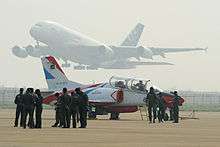Sherdils
| Sherdils | |
|---|---|
 Sherdils K-8 Karakorums fly in inverted formation over Islamabad | |
| Active | 1972–present |
| Country |
|
| Branch |
|
| Role | Aerobatics display |
| Size | 9 K-8 Karakorum aircraft |
| Garrison/HQ | Risalpur |
| Colors | Red, teal and white |
| Aircraft |
K-8 Karakorum (2010–present) Cessna T-37 Tweet (1972–2010) |

Sherdils (Urdu: ﺸﻴر دﻋﻝ) is the aerobatics display team of the Pakistan Air Force Academy based at the PAF Academy, Risalpur, Pakistan. The team flies nine K-8 Karakorum trainer aircraft and used to fly the T-37 "Tweety Bird". Its pilots are instructors from the PAF Academy's Basic Flying Training (BFT) Wing.
History
The team was officially formed on 17 August 1972 as a result of efforts by an Academy instructor, Sqn Ldr Bahar-ul-haq. The team was formed on the lines of Red Pelicans, the aerobatics team of RAF College, Cranwell where Bahar had been on an exchange tour. It was decided to put up a brief show on graduation parades as a demonstration of the professional skills of Academy instructors.
After several trials of candidate instructors, a team was formed under the command of 1965 War hero, Wg Cdr Imtiaz Bhatti. He was the Officer Commanding of the BFT wing at that time. Other formation members included Flt Lt Aamer Ali Sharieff, Flt Lt A Rahim Yusufzai and Flt Lt Niaz Nabi, the latter becoming a most durable master of the ‘slot’ position.
The initial performances of the team were highly successful. The "Tweety birds" performed at air shows for foreign dignitaries, including heads of state and military officers.
Initially, the team had no name. The personal call sign of the leaders also denoted the team; it flew as ‘Sherdils’ for the first time on 19 September 1974.
The Sherdils have transitioned from the T-37 which had virtually become their trademark, to the newer and more modern Hongdu K-8 "Karakorum" trainer jointly developed with China. The public debut was during PAF High Mark 2010 exercise in April 2010. Another public display using the K-8s was soon after, during the graduation ceremony at PAF Risalpur in November, 2009.
Formation style
The type of formation and sequence has virtually remained the same since the team’s inception – line astern to diamond formation during a loop, then clover-leaf, steep turn, barrel roll and finally, the breath-taking bomb-burst. Attempts were made to increase the number of aircraft in the team, but engine thrust demands were excessive for the outer formation members to cope with. A four aircraft diamond has thus remained the basic formation of the ‘Sherdils’. In 2004, the number of aircraft in the main formation were increased to six,performing loops in delta formation and barrel roll and steep turn in double arrow-head formation. In 2009, the team was shifted onto the K-8 aircraft of the Advanced Jet Training Squadron of PAF Academy, Risalpur. At present, the team comprises nine aircraft, with six ship main-team. rest three aircraft perform the initial run-in and break-off in a linear bomburst over the venue.
Paint scheme
Appreciating the important quality affecting display aircraft i.e., appearance, the T-37s were painted all red. However, maintenance of the red-painted aircraft without the costly polyurethane coating became a problem. The team reverted to the all-metal finish, with only the nose, wing tips and tail painted day-glow orange. In 1980, with the induction of six ex-USAF T-37s, which were polyurethane-coated all white, ‘Sherdils’ became a logical choice for a new titillating appearance. The dramatic ‘sunburst’ paint scheme was adopted, red rays on an all-white background. Later, the aircraft were again painted red, but with the rays in white, a scheme that is in vogue today. Coloured smoke has been used to enhance the aesthetic qualities of the formation; smoke trails give the impression of multi-coloured ribbons twirling in the sky.
Accidents and incidents
On 8 October 1978 during a practice session, the team leader Flt Lt Alamdar Hussain went down in a mid-air collision involving his slot man. He was posthumously awarded the Sitara-i-Basalat. He was Sword of Honor winner 54 GD(P) and younger brother of Former Vice Chief of Air Staff(Pakistan Airforce) Air Marshall Syed Qaiser Hussain (Retd).
See also
References
External links
![]() Media related to Sherdils at Wikimedia Commons
Media related to Sherdils at Wikimedia Commons